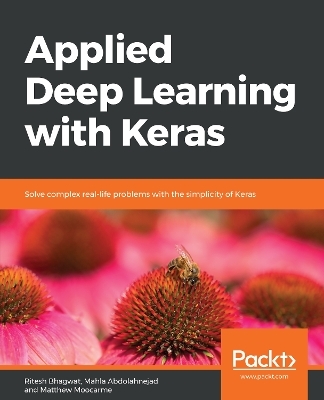
Applied Deep Learning with Keras
Packt Publishing Limited (Verlag)
978-1-83855-507-8 (ISBN)
Take your neural networks to a whole new level with the simplicity and modularity of Keras, the most commonly used high-level neural networks API.
Key Features
Solve complex machine learning problems with precision
Evaluate, tweak, and improve your deep learning models and solutions
Use different types of neural networks to solve real-world problems
Book DescriptionThough designing neural networks is a sought-after skill, it is not easy to master. With Keras, you can apply complex machine learning algorithms with minimum code.
Applied Deep Learning with Keras starts by taking you through the basics of machine learning and Python all the way to gaining an in-depth understanding of applying Keras to develop efficient deep learning solutions. To help you grasp the difference between machine and deep learning, the book guides you on how to build a logistic regression model, first with scikit-learn and then with Keras. You will delve into Keras and its many models by creating prediction models for various real-world scenarios, such as disease prediction and customer churning. You’ll gain knowledge on how to evaluate, optimize, and improve your models to achieve maximum information. Next, you’ll learn to evaluate your model by cross-validating it using Keras Wrapper and scikit-learn. Following this, you’ll proceed to understand how to apply L1, L2, and dropout regularization techniques to improve the accuracy of your model. To help maintain accuracy, you’ll get to grips with applying techniques including null accuracy, precision, and AUC-ROC score techniques for fine tuning your model.
By the end of this book, you will have the skills you need to use Keras when building high-level deep neural networks.
What you will learn
Understand the difference between single-layer and multi-layer neural network models
Use Keras to build simple logistic regression models, deep neural networks, recurrent neural networks, and convolutional neural networks
Apply L1, L2, and dropout regularization to improve the accuracy of your model
Implement cross-validate using Keras wrappers with scikit-learn
Understand the limitations of model accuracy
Who this book is forIf you have basic knowledge of data science and machine learning and want to develop your skills and learn about artificial neural networks and deep learning, you will find this book useful. Prior experience of Python programming and experience with statistics and logistic regression will help you get the most out of this book. Although not necessary, some familiarity with the scikit-learn library will be an added bonus.
Ritesh Bhagwat has a master's degree in applied mathematics with a specialization in computer science. He has over 14 years of experience in data-driven technologies and has led and been a part of complex projects ranging from data warehousing and business intelligence to machine learning and artificial intelligence. He has worked with top-tier global consulting firms as well as large multinational financial institutions. Currently, he works as a data scientist. Besides work, he enjoys playing and watching cricket and loves to travel. He is also deeply interested in Bayesian statistics. Mahla Abdolahnejad is a Ph.D. candidate in systems and computer engineering with Carleton University, Canada. She also holds a bachelor's degree and a master's degree in biomedical engineering, which first exposed her to the field of artificial intelligence and artificial neural networks, in particular. Her Ph.D. research is focused on deep unsupervised learning for computer vision applications. She is particularly interested in exploring the differences between a human's way of learning from the visual world and a machine's way of learning from the visual world, and how to push machine learning algorithms toward learning and thinking like humans. Matthew Moocarme is a director and senior data scientist in Viacom’s Advertising Science team. As a data scientist at Viacom, he designs data-driven solutions to help Viacom gain insights, streamline workflows, and solve complex problems using data science and machine learning. Matthew lives in New York City and outside of work enjoys combining deep learning with music theory. He is a classically-trained physicist, holding a Ph.D. in Physics from The Graduate Center of CUNY and is an active Artificial Intelligence developer, researcher, practitioner, and educator.
Table of Contents
Introduction to Machine Learning with Keras
Machine Learning versus Deep Learning
Deep Learning with Keras
Evaluate your Model with Cross Validation with Keras Wrappers
Improving Model Accuracy
Model Evaluation
Computer Vision with Convolutional Neural Networks
Transfer Learning and Pre-Trained Models
Sequential Modeling with Recurrent Neural Network
| Erscheinungsdatum | 29.04.2019 |
|---|---|
| Verlagsort | Birmingham |
| Sprache | englisch |
| Maße | 75 x 93 mm |
| Themenwelt | Mathematik / Informatik ► Informatik ► Programmiersprachen / -werkzeuge |
| Informatik ► Theorie / Studium ► Künstliche Intelligenz / Robotik | |
| ISBN-10 | 1-83855-507-2 / 1838555072 |
| ISBN-13 | 978-1-83855-507-8 / 9781838555078 |
| Zustand | Neuware |
| Haben Sie eine Frage zum Produkt? |
aus dem Bereich


